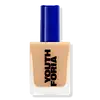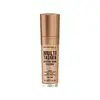Youthforia Date Night Skin Tint Serum Foundation Versus Rimmel London Rimmel Multi Tasker Better Than Filters
What's inside
What's inside
 Key Ingredients
Key Ingredients

 Benefits
Benefits

 Concerns
Concerns

No concerns
 Ingredients Side-by-side
Ingredients Side-by-side

Water
Skin ConditioningTitanium Dioxide
Cosmetic ColorantCetyl Ethylhexanoate
EmollientButylene Glycol Dicaprylate/Dicaprate
EmollientDicaprylyl Carbonate
EmollientIsododecane
EmollientHydrogenated Polydecene
EmollientPolyglyceryl-2 Oleate
EmulsifyingGlycerin
HumectantPolyhydroxystearic Acid
EmulsifyingMethyl Methacrylate Crosspolymer
Magnesium Stearate
Cosmetic ColorantMagnesium Sulfate
Centella Asiatica Extract
CleansingPolyglyceryl-2 Stearate
EmulsifyingDipropylene Glycol
HumectantDisteardimonium Hectorite
StabilisingSodium Hyaluronate
HumectantSodium Acetylated Hyaluronate
HumectantHydrolyzed Hyaluronic Acid
HumectantHydroxypropyltrimonium Hyaluronate
Sodium Hyaluronate Crosspolymer
HumectantHydroxyacetophenone
AntioxidantTocopheryl Acetate
AntioxidantPropylene Carbonate
SolventCaprylyl Glycol
EmollientButylene Glycol
HumectantDiospyros Kaki Leaf Extract
Skin ProtectingVitis Vinifera Fruit Extract
Skin ConditioningAllantoin
Skin ConditioningCeramide AP
Skin Conditioning1,2-Hexanediol
Skin ConditioningCoffea Arabica Seed Extract
MaskingCarthamus Tinctorius Flower Extract
Skin ConditioningPolygonum Cuspidatum Root Extract
AntioxidantCamellia Sinensis Leaf Extract
AntimicrobialCastanea Crenata Shell Extract
Skin ConditioningZanthoxylum Piperitum Fruit Extract
Skin ConditioningMaltodextrin
AbsorbentMethylpropanediol
SolventDipotassium Glycyrrhizate
HumectantPanthenol
Skin ConditioningPentylene Glycol
Skin ConditioningAdenosine
Skin ConditioningCapparis Spinosa Fruit Extract
Skin ConditioningDisodium Stearoyl Glutamate
CleansingOlea Europaea Leaf Extract
PerfumingOpuntia Ficus-Indica Stem Extract
Skin ConditioningHydroxyphenyl Propamidobenzoic Acid
Skin ConditioningEthylhexylglycerin
Skin ConditioningAscorbyl Palmitate
AntioxidantCI 77007
Cosmetic ColorantCI 77492
Cosmetic ColorantCI 77491
Cosmetic ColorantCI 77499
Cosmetic ColorantWater, Titanium Dioxide, Cetyl Ethylhexanoate, Butylene Glycol Dicaprylate/Dicaprate, Dicaprylyl Carbonate, Isododecane, Hydrogenated Polydecene, Polyglyceryl-2 Oleate, Glycerin, Polyhydroxystearic Acid, Methyl Methacrylate Crosspolymer, Magnesium Stearate, Magnesium Sulfate, Centella Asiatica Extract, Polyglyceryl-2 Stearate, Dipropylene Glycol, Disteardimonium Hectorite, Sodium Hyaluronate, Sodium Acetylated Hyaluronate, Hydrolyzed Hyaluronic Acid, Hydroxypropyltrimonium Hyaluronate, Sodium Hyaluronate Crosspolymer, Hydroxyacetophenone, Tocopheryl Acetate, Propylene Carbonate, Caprylyl Glycol, Butylene Glycol, Diospyros Kaki Leaf Extract, Vitis Vinifera Fruit Extract, Allantoin, Ceramide AP, 1,2-Hexanediol, Coffea Arabica Seed Extract, Carthamus Tinctorius Flower Extract, Polygonum Cuspidatum Root Extract, Camellia Sinensis Leaf Extract, Castanea Crenata Shell Extract, Zanthoxylum Piperitum Fruit Extract, Maltodextrin, Methylpropanediol, Dipotassium Glycyrrhizate, Panthenol, Pentylene Glycol, Adenosine, Capparis Spinosa Fruit Extract, Disodium Stearoyl Glutamate, Olea Europaea Leaf Extract, Opuntia Ficus-Indica Stem Extract, Hydroxyphenyl Propamidobenzoic Acid, Ethylhexylglycerin, Ascorbyl Palmitate, CI 77007, CI 77492, CI 77491, CI 77499
Water
Skin ConditioningDicaprylyl Carbonate
EmollientTrioctyldodecyl Citrate
EmollientIsododecane
Emollient2,3-Butanediol
HumectantGlycerin
HumectantPolyglyceryl-4 Diisostearate/Polyhydroxystearate/Sebacate
EmulsifyingDiisostearoyl Polyglyceryl-3 Dimer Dilinoleate
EmollientSodium Chloride
MaskingTrimethylsiloxysilicate
EmollientBoron Nitride
AbsorbentDisteardimonium Hectorite
StabilisingTocopheryl Acetate
AntioxidantXanthan Gum
Emulsifying1,2-Hexanediol
Skin ConditioningCaprylyl Glycol
EmollientChlorphenesin
AntimicrobialPropylene Carbonate
SolventPanthenol
Skin ConditioningTriethoxycaprylylsilane
Methicone
EmollientVaccinium Macrocarpon Fruit Extract
Astringent3-O-Ethyl Ascorbic Acid
Skin ConditioningTocopherol
AntioxidantPantolactone
HumectantMica
Cosmetic ColorantCI 77891
Cosmetic ColorantIron Oxides
Water, Dicaprylyl Carbonate, Trioctyldodecyl Citrate, Isododecane, 2,3-Butanediol, Glycerin, Polyglyceryl-4 Diisostearate/Polyhydroxystearate/Sebacate, Diisostearoyl Polyglyceryl-3 Dimer Dilinoleate, Sodium Chloride, Trimethylsiloxysilicate, Boron Nitride, Disteardimonium Hectorite, Tocopheryl Acetate, Xanthan Gum, 1,2-Hexanediol, Caprylyl Glycol, Chlorphenesin, Propylene Carbonate, Panthenol, Triethoxycaprylylsilane, Methicone, Vaccinium Macrocarpon Fruit Extract, 3-O-Ethyl Ascorbic Acid, Tocopherol, Pantolactone, Mica, CI 77891, Iron Oxides
Ingredients Explained
These ingredients are found in both products.
Ingredients higher up in an ingredient list are typically present in a larger amount.
1,2-Hexanediol is a synthetic liquid and another multi-functional powerhouse.
It is a:
- Humectant, drawing moisture into the skin
- Emollient, helping to soften skin
- Solvent, dispersing and stabilizing formulas
- Preservative booster, enhancing the antimicrobial activity of other preservatives
Caprylyl Glycol is a humectant and emollient, meaning it attracts and preserves moisture.
It is a common ingredient in many products, especially those designed to hydrate skin. The primary benefits are retaining moisture, skin softening, and promoting a healthy skin barrier.
Though Caprylyl Glycol is an alcohol derived from fatty acids, it is not the kind that can dry out skin.
This ingredient is also used as a preservative to extend the life of products. It has slight antimicrobial properties.
Learn more about Caprylyl GlycolDicaprylyl Carbonate comes from carbonic acid and caprylyl alcohol, a fatty alcohol. It is an emollient and gives skin a velvet feel. The sources of Dicaprylyl Carbonate may be synthetic or from animals.
As an emollient, Dicaprylyl Carbonate creates a film on the skin. This film traps moisture in, keeping your skin soft and hydrated.
Disteardimonium Hectorite comes from the clay mineral named hectorite. It is used to add thickness to a product.
It can also help stabilize a product by helping to disperse other ingredients.
Hectorite is a rare, white clay mineral.
Learn more about Disteardimonium HectoriteGlycerin is already naturally found in your skin. It helps moisturize and protect your skin.
A study from 2016 found glycerin to be more effective as a humectant than AHAs and hyaluronic acid.
As a humectant, it helps the skin stay hydrated by pulling moisture to your skin. The low molecular weight of glycerin allows it to pull moisture into the deeper layers of your skin.
Hydrated skin improves your skin barrier; Your skin barrier helps protect against irritants and bacteria.
Glycerin has also been found to have antimicrobial and antiviral properties. Due to these properties, glycerin is often used in wound and burn treatments.
In cosmetics, glycerin is usually derived from plants such as soybean or palm. However, it can also be sourced from animals, such as tallow or animal fat.
This ingredient is organic, colorless, odorless, and non-toxic.
Glycerin is the name for this ingredient in American English. British English uses Glycerol/Glycerine.
Learn more about GlycerinIsododecane is a fragrance, emollient, and solvent.
As an emollient, it helps your skin stay soft and hydrated. Emollients help trap moisture into your skin.
Isododecane's role as a solvent makes it a great texture enhancer. It spreads smoothly on skin and does not leave a sticky feeling behind. Isododecane also helps prevent color transfer in makeup products.
Isododecane is not absorbed into skin.
Learn more about IsododecanePanthenol is a common ingredient that helps hydrate and soothe the skin. It is found naturally in our skin and hair.
There are two forms of panthenol: D and L.
D-panthenol is also known as dexpanthenol. Most cosmetics use dexpanthenol or a mixture of D and L-panthenol.
Panthenol is famous due to its ability to go deeper into the skin's layers. Using this ingredient has numerous pros (and no cons):
Like hyaluronic acid, panthenol is a humectant. Humectants are able to bind and hold large amounts of water to keep skin hydrated.
This ingredient works well for wound healing. It works by increasing tissue in the wound and helps close open wounds.
Once oxidized, panthenol converts to pantothenic acid. Panthothenic acid is found in all living cells.
This ingredient is also referred to as pro-vitamin B5.
Learn more about PanthenolThis ingredient is a solvent. It helps dissolve active ingredients and alter the texture of products.
Propylene Carbonate is commonly used in makeup and with clay, such as montmorillonite or bentonite.
Studies show this ingredient to be safe for cosmetics. When it is undiluted, it can cause skin irritation. (It is always diluted in skincare and makeup). This ingredient is water-soluble.
Propylene Carbonate is created from propylene glycol and carbonic acid.
Learn more about Propylene CarbonateTocopheryl Acetate is AKA Vitamin E. It is an antioxidant and protects your skin from free radicals. Free radicals damage the skin by breaking down collagen.
One study found using Tocopheryl Acetate with Vitamin C decreased the number of sunburned cells.
Tocopheryl Acetate is commonly found in both skincare and dietary supplements.
Learn more about Tocopheryl AcetateWater. It's the most common cosmetic ingredient of all. You'll usually see it at the top of ingredient lists, meaning that it makes up the largest part of the product.
So why is it so popular? Water most often acts as a solvent - this means that it helps dissolve other ingredients into the formulation.
You'll also recognize water as that liquid we all need to stay alive. If you see this, drink a glass of water. Stay hydrated!
Learn more about Water